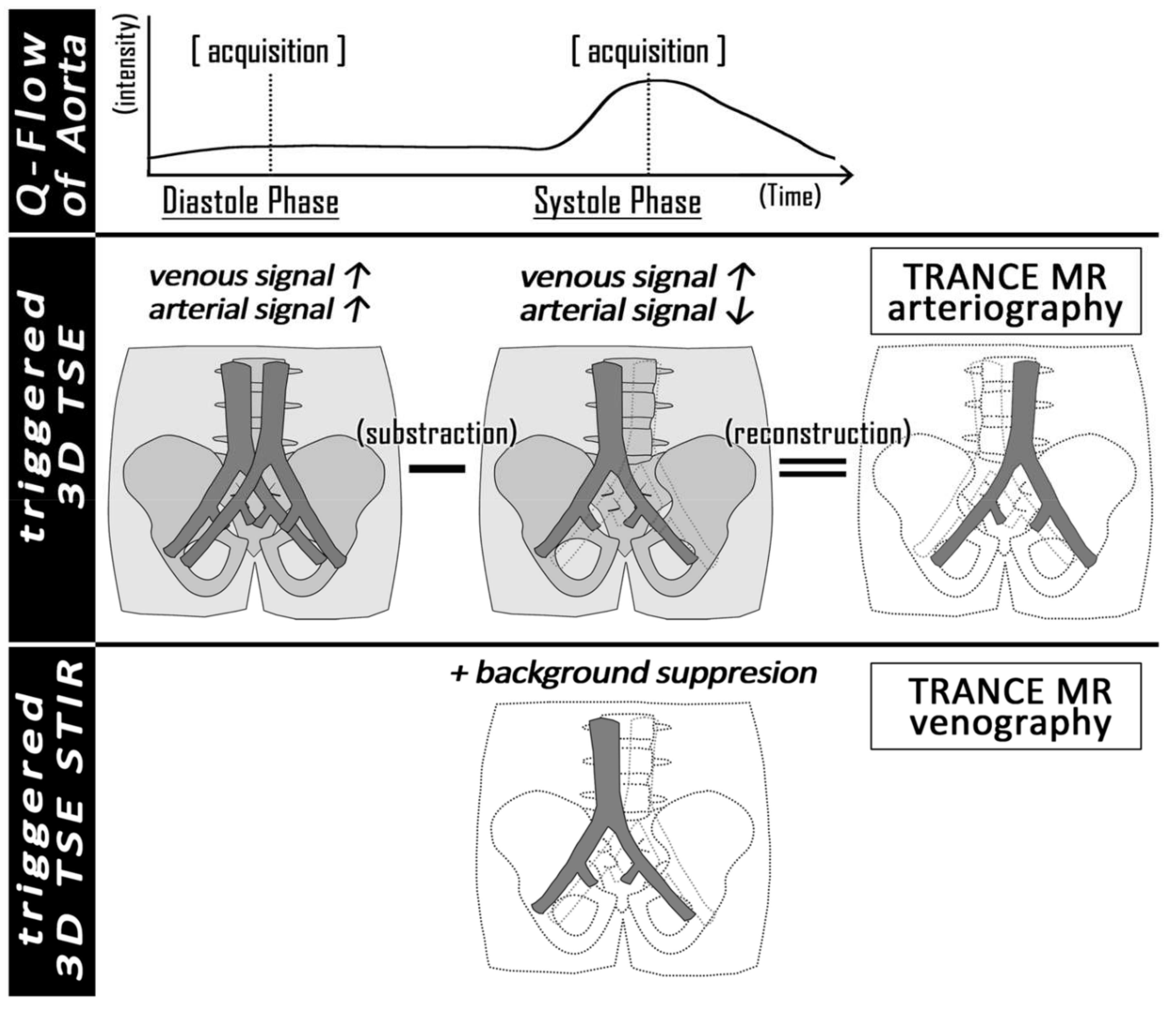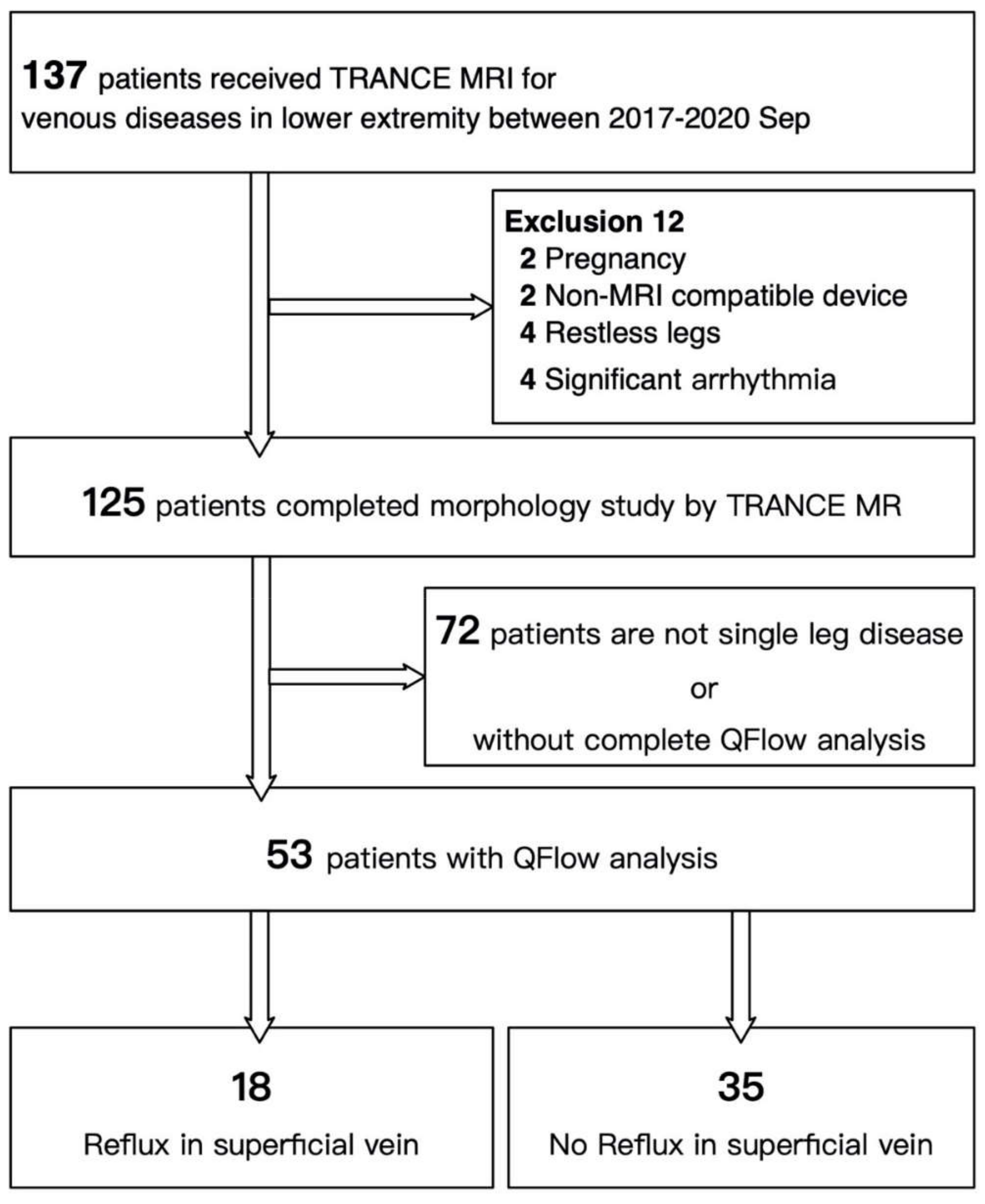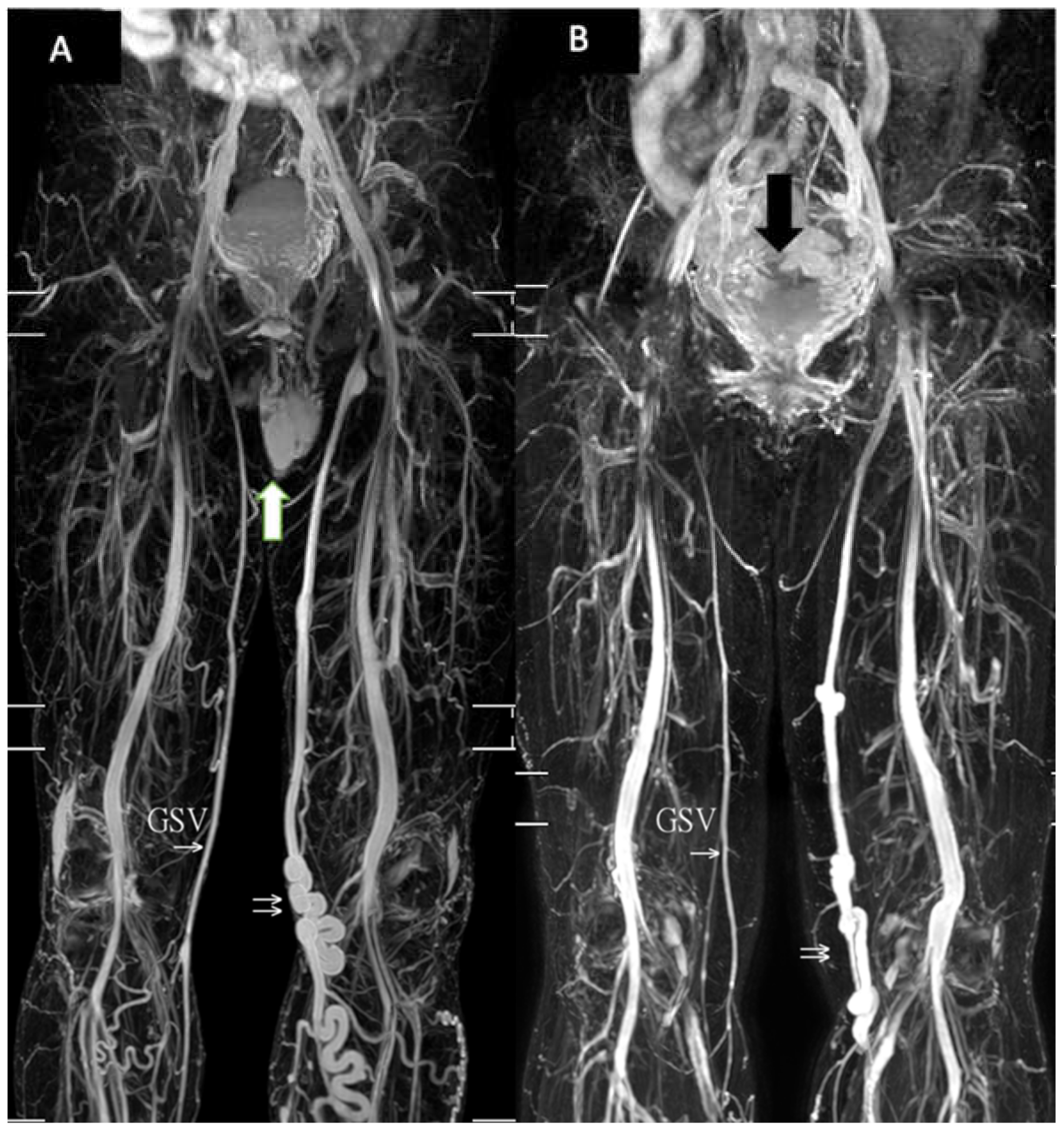Discriminating Reflux from Non-Reflux Diseases of Superficial Veins in Legs by Novel Non-Contrast MR with QFlow Technique
Abstract
1. Background
2. Methods
2.1. Patients
2.2. MRI Acquisition
2.3. Statistical Analysis
3. Results
4. Discussion
Study Limitations
5. Conclusions
6. Patents
Supplementary Materials
Author Contributions
Funding
Institutional Review Board Statement
Informed Consent Statement
Data Availability Statement
Acknowledgments
Conflicts of Interest
Abbreviations
| 3D | three-dimensional |
| CT | computed tomography |
| CTA | computed tomography angiography |
| DVT | deep venous thrombosis |
| EIV | external iliac vein |
| FFV | forward flow volume |
| FOV | field of view |
| FV | femoral vein |
| GSV | great saphenous vein |
| IR | inversion recovery |
| IRB | institutional review board |
| MF | mean flux |
| MRI | magnetic resonance imaging |
| MRV | magnetic resonance venography |
| MV | mean velocity |
| NSF | nephrogenic systemic fibrosis |
| PV | popliteal vein |
| ROC | receiver operating characteristic |
| SD | stroke distance |
| STIR | short tau inversion recovery |
| SV | stroke volume |
| TE | echo time |
| TOF | time-of-flight |
| TR | repetition time |
| TRANCE-MRI | triggered angiography non-contrast-enhanced MRI |
| TSE | turbo spin-echo |
| US | ultrasonography |
References
- Tassiopoulos, A.K.; Golts, E.; Oh, D.S.; Labropoulos, N. Current concepts in chronic venous ulceration. Eur. J. Vasc. Endovasc. Surg. 2000, 20, 227–232. [Google Scholar] [CrossRef][Green Version]
- Schleimer, K.; Barbati, M.E.; Grommes, J.; Hoeft, K.; Toonder, I.M.; Wittens, C.H.A.; Jalaie, H. Update on diagnosis and treatment strategies in patients with post-thrombotic syndrome due to chronic venous obstruction and role of endovenous recanalization. J. Vasc. Surg. Venous Lymphat. Disord. 2019, 7, 592–600. [Google Scholar] [CrossRef]
- Bonkemeyer Millan, S.; Gan, R.; Townsend, P.E. Venous Ulcers: Diagnosis and Treatment. Am. Fam. Physician 2019, 100, 298–305. [Google Scholar]
- Lin, B.S.; Chen, C.W.; Zhou, S.K.; Tseng, Y.H.; Wang, S.C.; Huang, Y.K. Evaluation of static ulcer on lower extremities using wireless wearable near-infrared spectroscopy device: Effect of deep venous thrombosis on TRiggered Angiography Non-Contrast-Enhanced sequence magnetic resonance imaging. Phlebology 2020, 268355520935739. [Google Scholar] [CrossRef] [PubMed]
- Kao, C.C.; Chen, C.W.; Tseng, Y.H.; Tsai, Y.H.; Wang, S.C.; Huang, Y.K. Non-contrast-enhanced magnetic resonance imaging: Objective figures in differentiation between acute and chronic deep venous thrombosis in the lower extremities. Phlebology 2020, 268355520939375. [Google Scholar] [CrossRef] [PubMed]
- Chen, C.W.; Tseng, Y.H.; Lin, C.C.; Kao, C.C.; Wong, M.Y.; Lin, B.S.; Huang, Y.K. Novel Diagnostic Options without Contrast Media or Radiation: Triggered Angiography Non-Contrast-Enhanced Sequence Magnetic Resonance Imaging in Treating Different Leg Venous Diseases. Diagnostics 2020, 10, 355. [Google Scholar] [CrossRef] [PubMed]
- Coleridge-Smith, P.; Labropoulos, N.; Partsch, H.; Myers, K.; Nicolaides, A.; Cavezzi, A. Duplex ultrasound investigation of the veins in chronic venous disease of the lower limbs--UIP consensus document. Part I. Basic principles. Eur. J. Vasc. Endovasc. Surg. 2006, 31, 83–92. [Google Scholar] [CrossRef] [PubMed]
- Marsden, G.; Perry, M.; Kelley, K.; Davies, A.H.; Guideline Development, G. Diagnosis and management of varicose veins in the legs: Summary of NICE guidance. BMJ 2013, 347, f4279. [Google Scholar] [CrossRef] [PubMed]
- Asciutto, G.; Mumme, A.; Marpe, B.; Koster, O.; Asciutto, K.C.; Geier, B. MR venography in the detection of pelvic venous congestion. Eur. J. Vasc. Endovasc. Surg. 2008, 36, 491–496. [Google Scholar] [CrossRef] [PubMed]
- Lee, Y.L.; Huang, Y.K.; Hsu, L.S.; Chen, P.Y.; Chen, C.W. The use of non-contrast-enhanced MRI to evaluate serial changes in endoleaks after aortic stenting: A case report. BMC Med. Imaging 2019, 19, 82. [Google Scholar] [CrossRef]
- Huang, Y.K.; Tseng, Y.H.; Lin, C.H.; Tsai, Y.H.; Hsu, Y.C.; Wang, S.C.; Chen, C.W. Evaluation of venous pathology of the lower extremities with triggered angiography non-contrast-enhanced magnetic resonance imaging. BMC Med. Imaging 2019, 19, 96. [Google Scholar] [CrossRef]
- Rossi, F.H.; Kambara, A.M.; Rodrigues, T.O.; Rossi, C.B.O.; Izukawa, N.M.; Pinto, I.M.F.; Thorpe, P.E. Comparison of computed tomography venography and intravascular ultrasound in screening and classification of iliac vein obstruction in patients with chronic venous disease. J. Vasc. Surg. Venous Lymphat. Disord. 2020, 8, 413–422. [Google Scholar] [CrossRef] [PubMed]
- Montminy, M.L.; Thomasson, J.D.; Tanaka, G.J.; Lamanilao, L.M.; Crim, W.; Raju, S. A comparison between intravascular ultrasound and venography in identifying key parameters essential for iliac vein stenting. J. Vasc. Surg. Venous Lymphat. Disord. 2019, 7, 801–807. [Google Scholar] [CrossRef]
- Goodman, L.R. Venous thromboembolic disease: CT evaluation. Q. J. Nucl. Med. 2001, 45, 302–310. [Google Scholar]
- Gurel, K.; Gurel, S.; Karavas, E.; Buharalioglu, Y.; Daglar, B. Direct contrast-enhanced MR venography in the diagnosis of May-Thurner syndrome. Eur. J. Radiol. 2011, 80, 533–536. [Google Scholar] [CrossRef] [PubMed]
- Ruehm, S.G.; Zimny, K.; Debatin, J.F. Direct contrast-enhanced 3D MR venography. Eur. Radiol. 2001, 11, 102–112. [Google Scholar] [CrossRef]
- Alfano, G.; Fontana, F.; Ferrari, A.; Solazzo, A.; Perrone, R.; Giaroni, F.; Torricelli, P.; Cappelli, G. Incidence of nephrogenic systemic fibrosis after administration of gadoteric acid in patients on renal replacement treatment. Magn. Reson. Imaging 2020, 70, 1–4. [Google Scholar] [CrossRef] [PubMed]
- Schieda, N.; Maralani, P.J.; Hurrell, C.; Tsampalieros, A.K.; Hiremath, S. Updated Clinical Practice Guideline on Use of Gadolinium-Based Contrast Agents in Kidney Disease Issued by the Canadian Association of Radiologists. Can. Assoc. Radiol. J. 2019, 70, 226–232. [Google Scholar] [CrossRef]
- Ross, M.R.; Pelc, N.J.; Enzmann, D.R. Qualitative phase contrast MRA in the normal and abnormal circle of Willis. AJNR Am. J. Neuroradiol. 1993, 14, 19–25. [Google Scholar]
- Forner Giner, J.; Sanz-Requena, R.; Florez, N.; Alberich-Bayarri, A.; Garcia-Marti, G.; Ponz, A.; Marti-Bonmati, L. Quantitative phase-contrast MRI study of cerebrospinal fluid flow: A method for identifying patients with normal-pressure hydrocephalus. Neurologia 2014, 29, 68–75. [Google Scholar] [CrossRef]
- Gutzeit, A.; Sutter, R.; Froehlich, J.M.; Roos, J.E.; Sautter, T.; Schoch, E.; Giger, B.; Wyss, M.; Graf, N.; von Weymarn, C.; et al. ECG-triggered non-contrast-enhanced MR angiography (TRANCE) versus digital subtraction angiography (DSA) in patients with peripheral arterial occlusive disease of the lower extremities. Eur. Radiol. 2011, 21, 1979–1987. [Google Scholar] [CrossRef]
- Suttmeyer, B.; Teichgraber, U.; Rathke, H.; Albrecht, L.; Guttler, F.; Schnackenburg, B.; Hamm, B.; de Bucourt, M. Initial experience with imaging of the lower extremity arteries in an open 1.0 Tesla MRI system using the triggered angiography non-contrast-enhanced sequence (TRANCE) compared to digital subtraction angiography (DSA). Biomed. Tech. 2016, 61, 383–392. [Google Scholar] [CrossRef] [PubMed]
- Radlbauer, R.; Salomonowitz, E.; van der Riet, W.; Stadlbauer, A. Triggered non-contrast enhanced MR angiography of peripheral arteries: Optimization of systolic and diastolic time delays for electrocardiographic triggering. Eur. J. Radiol. 2011, 80, 331–335. [Google Scholar] [CrossRef] [PubMed]
- Ohno, N.; Miyati, T.; Noda, T.; Alperin, N.; Hamaguchi, T.; Ohno, M.; Matsushita, T.; Mase, M.; Gabata, T.; Kobayashi, S. Fast Phase-Contrast Cine MRI for Assessing Intracranial Hemodynamics and Cerebrospinal Fluid Dynamics. Diagnostics 2020, 10, 241. [Google Scholar] [CrossRef]
- Altaha, M.A.; Jaskolka, J.D.; Tan, K.; Rick, M.; Schmitt, P.; Menezes, R.J.; Wintersperger, B.J. Non-contrast-enhanced MR angiography in critical limb ischemia: Performance of quiescent-interval single-shot (QISS) and TSE-based subtraction techniques. Eur. Radiol. 2017, 27, 1218–1226. [Google Scholar] [CrossRef] [PubMed]





| Variable | Total (n = 53) | Reflux (n = 18) | No Reflux (n = 35) | p Value |
|---|---|---|---|---|
| Male sex | 15 (28.3) | 7 (38.9) | 8 (22.9) | 0.334 |
| Age, year | 59.7 ± 14.1 | 56.9 ± 12.9 | 61.1 ± 14.7 | 0.317 |
| Substance use | ||||
| Smoking | 10 (18.9) | 5 (27.8) | 5 (14.3) | 0.279 |
| Alcohol | 3 (5.7) | 1 (5.6) | 2 (5.7) | 1.000 |
| Betel nuts | 3 (5.7) | 2 (11.1) | 1 (2.9) | 0.263 |
| Comorbidities | ||||
| Hypertension | 15 (28.3) | 3 (16.7) | 12 (34.3) | 0.215 |
| Diabetes | 8 (15.1) | 2 (11.1) | 6 (17.1) | 0.701 |
| Coronary artery disease | 1 (1.9) | 0 (0.0) | 1 (2.9) | 1.000 |
| Deep vein thrombosis | 6 (11.3) | 0 (0.0) | 6 (17.1) | 0.085 |
| Cancer | 8 (15.1) | 1 (5.6) | 7 (20.0) | 0.240 |
| Left leg involved | 32 (60.4) | 8 (44.4) | 24 (68.6) | 0.138 |
| Chronic leg ulcer | 8 (15.1) | 5 (27.8) | 3 (8.6) | 0.104 |
| Variable | Total (N = 53) | Reflux (n = 18) | No Reflux (n = 35) | p | AUC, % (95% CI) * | Cutoff # | Sensitivity, % (95% CI) | Specificity, % (95% CI) |
|---|---|---|---|---|---|---|---|---|
| SV | ||||||||
| EIV | 100 (60, 124) | 102 (78, 119) | 82 (49, 132) | 0.367 | 55.0 (37.3–72.7) | NA | NA | NA |
| FV | 91 (60, 136) | 101 (64, 165) | 80 (52, 128) | 0.237 | 57.1 (38.6–75.7) | NA | NA | NA |
| (EIV/FV) * 100 | 86 (58, 147) | 99 (66, 147) | 73 (53, 157) | 0.419 | 60.7 (42.9–78.5) | NA | NA | NA |
| GSV | 130 (72, 766) | 276 (126, 875) | 105 (59, 600) | 0.047 * | 68.8 (52.7–85.0) * | >108.6 | 85.7 (57.2–98.2) | 53.3 (34.3–71.7) |
| PV | 89 (53, 120) | 78 (51, 207) | 92 (53, 120) | 0.851 | 52.9 (32.5–73.2) | NA | NA | NA |
| (GSV/PV) * 100 | 154 (79, 518) | 257 (152, 563) | 126 (61, 472) | 0.087 | 66.2 (49.7–82.7) | NA | NA | NA |
| FFV | ||||||||
| EIV | 92 (56, 121) | 101 (70, 116) | 84 (47, 132) | 0.430 | 53.8 (36.2–71.4) | NA | NA | NA |
| FV | 95 (64, 136) | 101 (64, 165) | 92 (58, 128) | 0.320 | 56.7 (38.1–75.3) | NA | NA | NA |
| (EIV/FV) * 100 | 81 (49, 145) | 99 (61, 147) | 72 (45, 124) | 0.348 | 58.6 (41.0–76.1) | NA | NA | NA |
| GSV | 125 (81, 332) | 276 (126, 821) | 108 (64, 183) | 0.008 * | 74.9 (59.3–90.4) * | >114.3 | 85.7 (57.2–98.2) | 60 (40.6–77.3) |
| PV | 92 (63, 120) | 78 (52, 207) | 97 (71, 120) | 0.693 | 55.0 (34.5–75.5) | NA | NA | NA |
| (GSV/PV) * 100 | 147 (73, 312) | 260 (156, 563) | 109 (63, 222) | 0.011 * | 74.0 (58.5–89.6) * | >222.0 | 71.4 (41.9–91.6) | 76.7 (57.7–90.1) |
| MF | ||||||||
| EIV | 100 (59, 124) | 102 (70, 119) | 82 (49, 133) | 0.419 | 55.2 (37.6–72.8) | NA | NA | NA |
| FV | 95 (64, 136) | 102 (64, 164) | 89 (59, 127) | 0.302 | 57.6 (39.1–76.1) | NA | NA | NA |
| (EIV/FV) * 100 | 83 (55, 146) | 96 (65, 147) | 71 (53, 124) | 0.338 | 61.2 (43.4–79.0) | NA | NA | NA |
| GSV | 129 (67, 778) | 276 (125, 847) | 106 (60, 600) | 0.049 * | 68.6 (52.4–84.8) * | >109.3 | 85.7 (57.2–98.2) | 53.3 (34.3–71.7) |
| PV | 88 (61, 120) | 77 (51, 209) | 92 (65, 120) | 0.778 | 53.8 (33.4–74.2) | NA | NA | NA |
| (GSV/PV) * 100 | 160 (80, 538) | 257 (157, 569) | 119 (61, 507) | 0.078 | 66.7 (50.4–83.0) * | >136.5 | 78.6 (49.2–95.3) | 60.0 (40.6–77.3) |
| SD | ||||||||
| EIV | 98 (71, 123) | 101 (74, 123) | 88 (57, 128) | 0.237 | 61.0 (43.0–78.9) | NA | NA | NA |
| FV | 94 (76, 128) | 94 (76, 128) | 94 (70, 129) | 0.910 | 53.8 (35.6–72.0) | NA | NA | NA |
| (EIV/FV) * 100 | 94 (64, 122) | 106 (77, 163) | 82 (51, 119) | 0.051 | 66.5 (51.3–81.7) * | >101.0 | 61.1 (35.7–82.7) | 68.6 (50.7–83.1) |
| GSV | 126 (73, 423) | 224 (118, 765) | 93 (50, 365) | 0.049 * | 68.6 (53.0–84.2) * | >86 | 92.9 (66.1–99.8) | 50.0 (31.3–68.7) |
| PV | 91 (57, 119) | 74 (53, 111) | 98 (64, 120) | 0.276 | 59.8 (38.8–80.7) | NA | NA | NA |
| (GSV/PV) * 100 | 135 (66, 333) | 204 (133, 582) | 112 (39, 318) | 0.047 * | 68.8 (53.0–84.7) * | >117.1 | 85.7 (57.2–98.2) | 56.7 (37.4–74.5) |
| MV | ||||||||
| EIV | 99 (71, 128) | 101 (73, 151) | 88 (57, 128) | 0.176 | 61.0 (43.0–78.9) | NA | NA | NA |
| FV | 94 (76, 128) | 94 (76, 128) | 94 (70, 129) | 0.910 | 53.8 (35.6–72.0) | NA | NA | NA |
| (EIV/FV) * 100 | 94 (63, 129) | 109 (77, 165) | 82 (51, 119) | 0.035 * | 67.8 (52.5–83.1) * | >100.9 | 61.1 (35.7–82.7) | 68.6 (50.7–83.1) |
| GSV | 126 (73, 382) | 300 (118, 768) | 93 (56, 338) | 0.034 * | 70.0 (54.6–85.4) * | >86.1 | 92.3 (66.1–99.8) | 50.0 (31.3–68.7) |
| PV | 91 (57, 119) | 74 (54, 111) | 98 (64, 120) | 0.276 | 59.8 (38.8–80.7) | NA | NA | NA |
| (GSV/PV) * 100 | 135 (66, 332) | 206 (133, 585) | 112 (40, 318) | 0.025 * | 71.2 (55.7–86.7) * | >122.9 | 85.7 (57.2–98.2) | 60.0 (40.6–77.3) |
Publisher’s Note: MDPI stays neutral with regard to jurisdictional claims in published maps and institutional affiliations. |
© 2021 by the authors. Licensee MDPI, Basel, Switzerland. This article is an open access article distributed under the terms and conditions of the Creative Commons Attribution (CC BY) license (http://creativecommons.org/licenses/by/4.0/).
Share and Cite
Tseng, Y.-H.; Chen, C.-W.; Wong, M.Y.; Yang, T.-Y.; Lin, B.-S.; Ting, H.; Huang, Y.-K. Discriminating Reflux from Non-Reflux Diseases of Superficial Veins in Legs by Novel Non-Contrast MR with QFlow Technique. J. Pers. Med. 2021, 11, 242. https://doi.org/10.3390/jpm11040242
Tseng Y-H, Chen C-W, Wong MY, Yang T-Y, Lin B-S, Ting H, Huang Y-K. Discriminating Reflux from Non-Reflux Diseases of Superficial Veins in Legs by Novel Non-Contrast MR with QFlow Technique. Journal of Personalized Medicine. 2021; 11(4):242. https://doi.org/10.3390/jpm11040242
Chicago/Turabian StyleTseng, Yuan-Hsi, Chien-Wei Chen, Min Yi Wong, Teng-Yao Yang, Bor-Shyh Lin, Hua Ting, and Yao-Kuang Huang. 2021. "Discriminating Reflux from Non-Reflux Diseases of Superficial Veins in Legs by Novel Non-Contrast MR with QFlow Technique" Journal of Personalized Medicine 11, no. 4: 242. https://doi.org/10.3390/jpm11040242
APA StyleTseng, Y.-H., Chen, C.-W., Wong, M. Y., Yang, T.-Y., Lin, B.-S., Ting, H., & Huang, Y.-K. (2021). Discriminating Reflux from Non-Reflux Diseases of Superficial Veins in Legs by Novel Non-Contrast MR with QFlow Technique. Journal of Personalized Medicine, 11(4), 242. https://doi.org/10.3390/jpm11040242






